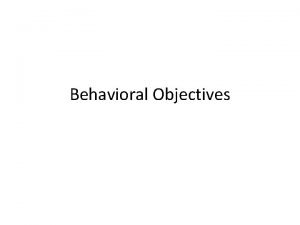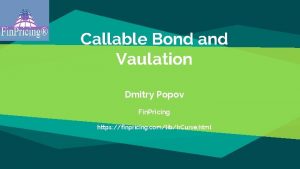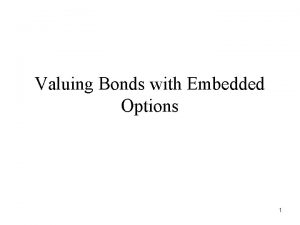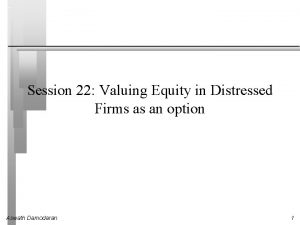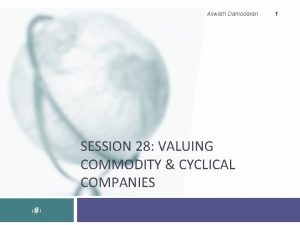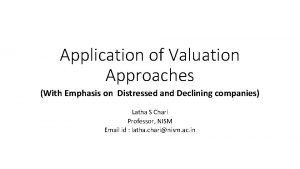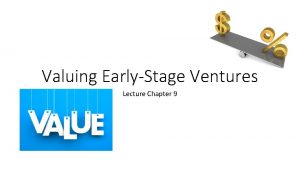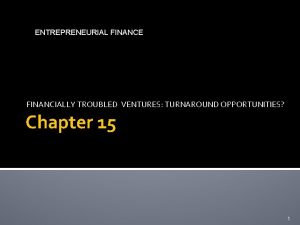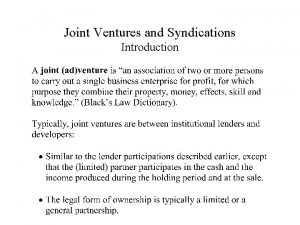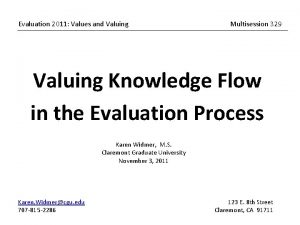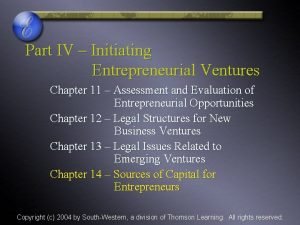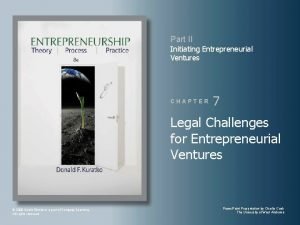ENTREPRENEURIAL FINANCE VALUING EARLYSTAGE VENTURES Chapter 9 1




















- Slides: 20

ENTREPRENEURIAL FINANCE VALUING EARLY-STAGE VENTURES Chapter 9 1

Chapter 9: Learning Objectives � Explain why it is important to look to the future when determining a venture’s value � Describe how the time pattern of cash flows relates to venture value � Understand the need to consider both forecast period and terminal value cash flows when determining a venture’s value � Understand the difference between required cash and surplus cash � Describe the process for developing the projected financial statements used in a valuation � Describe how pseudo dividends are incorporated into the discounted cash flow equity valuation method � Understand the differences between accounting and equity valuation cash flow 2

What is a Venture Theoretically Worth? � Present value (PV): value today of all future cash flows discounted to the present at the investor’s required rate of return � “Investors pay for the future; entrepreneurs pay for the past. ” � “If you’re not using estimates, you’re not doing a valuation. ” 3

Basic Mechanics Of Valuation � Discounted cash flow (DCF): valuation approach involving discounting future cash flows for risk and delay � Explicit forecast period: two- to ten-year period in which the venture’s financial statements are explicitly forecast � Terminal (or horizon) value: value of the venture at the end of the explicit forecast period � Stepping stone year: first year after the explicit forecast period 4

Divide and Conquer: Terminal 5

Brewpub Example: 6

Useful Terms � Capitalization (cap) Rate: spread between the discount rate and the growth rate of cash flow in terminal value period (r – g) � Reversion value: present value of the terminal value � Pre-Money Valuation: present value of a venture prior to a new money investment � Post-Money Valuation: pre-money valuation of a venture plus money injected by new investors 7

More Useful Terms � Net Present Value (NPV): present value of a set of future flows plus the current undiscounted flow � Required Cash: amount of cash needed to cover a venture’s day-to-day operations � Surplus Cash: cash remaining after required cash, all operating expenses, and reinvestments are made 8

Required vs. Surplus Cash �Required Cash: amount of cash needed to cover a venture’s day-to-day operations �Surplus Cash: cash remaining after required cash, all operating expenses, and reinvestments are made �Example: in Table 9. 1, PDC has only required cash prior to July and then has 6, 487 of surplus cash in July. 9

Equity Valuation: A Pseudo Dividend Approach �Project PDC out five years assuming that a “surplus cash” account “plugs” the balance sheet (catching all remaining cash) �Calculate pseudo dividends by making sure that required investments in working capital do not include surplus cash �Discount the resulting pseudo dividends to get a value for the venture’s equity ownership 10

Pseudo Dividends (Equity VCFs) �Pseudo Dividend (Equity Valuation Cash Flow) = Net Income + Depreciation and Amortization Expense - Change in Net Operating Working Capital (w/o surplus cash) - Capital Expenditures + Net Debt Issues 11

Where We Exclude Surplus Cash in the Calculation of Required Working Capital For example, the NOWC calculation for PDC from March to July: Current assets July balance March balance Change in current assets 175, 307 – 174, 340 967 Surplus cash July amount March amount Change in surplus cash 6, 487 – 0 6, 487 Current liabilities July amount March amount Change in current liabilities 45, 310 – 48, 415 – 3, 105 Change in net operating working capital (= 967 – 6, 487 + 3, 105) – 2, 415 (= 967 – 6, 487 + 3, 105) 12

PDC Equity Valuation Cash Flow (March to July) � March to July Pseudo Dividend (Equity VCF) for PDC is: Net Income + Deprec. & Amort. Exp. - Change in NOWC (w/o surplus cash) - Capital Expenditures + Net Debt Issues = Equity Valuation Cash Flow $6, 372 +4, 600 +2, 415 - 6, 900 - 0 $6, 487 13

After July, project for 5 years 14

Balance Sheets with Surplus Cash “Plug” 15

16

Calculating the Pseudo Dividends (Equity VCFs) with for NOWC Calculations 17

The Real Economics Behind Pseudo Dividend Valuation … 18

… The Present Value of Those Projected Maximum Dividends 19

20
 7 pathways
7 pathways Palcahol
Palcahol Strategic issues in entrepreneurial ventures
Strategic issues in entrepreneurial ventures Financial preparation for entrepreneurial ventures
Financial preparation for entrepreneurial ventures Characteristics of entrepreneurial ventures
Characteristics of entrepreneurial ventures Damodaran control premium
Damodaran control premium Learning objective verbs
Learning objective verbs Psychomotor objectives examples
Psychomotor objectives examples Affective behavior at the level of valuing
Affective behavior at the level of valuing Triumvirate rome
Triumvirate rome Oral language quotes
Oral language quotes Valuing innovation
Valuing innovation Valuation of ip
Valuation of ip Descriptive ethics vs normative ethics
Descriptive ethics vs normative ethics Vaulation
Vaulation Valuing bonds with embedded options
Valuing bonds with embedded options Valuing distressed companies
Valuing distressed companies Valuing culture
Valuing culture Valuing land for social housing
Valuing land for social housing Valuing cyclical companies
Valuing cyclical companies Valuing distressed and declining companies
Valuing distressed and declining companies







